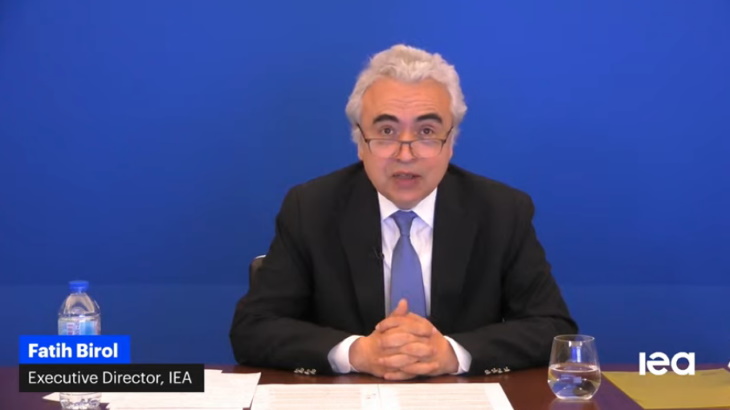RE:RE:RE:RE:RE:RE:RE:RE:RE:RE:I like the new sounding Bill Willoughby  https://world-nuclear-news.org/Articles/IEA-presents-energy-roadmap-to-achieve-net-zero-by
https://world-nuclear-news.org/Articles/IEA-presents-energy-roadmap-to-achieve-net-zero-by "
IEA presents energy roadmap to net zero by 2050
18 May 2021
The International Energy Agency (IEA) today published a report outlining the essential conditions for the global energy sector to reach net-zero CO2 emissions by 2050. It presents the "most technically feasible, cost-effective and socially acceptable pathway" for achieving this. Nuclear energy, the IEA says, will make "a significant contribution" in the Net Zero Emission scenario and will "provide an essential foundation for transitions" to a net-zero emissions energy system.
 IEA Executive Director Fatih Birol launching the report today
IEA Executive Director Fatih Birol launching the report today "The number of countries that have pledged to reach net-zero emissions by mid-century or soon after continues to grow, but so do global greenhouse gas emissions," the report says. "This gap between rhetoric and action needs to close if we are to have a fighting chance of reaching net zero by 2050 and limiting the rise in global temperatures to 1.5°C. Doing so requires nothing short of a total transformation of the energy systems that underpin our economies."
The report - Net Zero by 2050: A Roadmap for the Global Energy Sector - presents a Net-Zero Emissions by 2050 Scenario (NZE) designed to show what is needed across the main sectors by various actors, and by when, for the world to achieve net-zero energy-related and industrial process CO2 emissions by 2050. It also aims to minimise methane emissions from the energy sector. In recent years, the energy sector was responsible for around three-quarters of global greenhouse gas (GHG) emissions. In parallel with action on reducing all other sources of GHG emissions, achieving net-zero CO2 emissions from the energy sector by 2050 is consistent with around a 50% chance of limiting the long-term average global temperature rise to 1.5°C without a temperature overshoot, the IEA says.
The projections in the NZE were generated by a hybrid model that combines components of the IEA's World Energy Model, which is used to produce the projections in the annual World Energy Outlook, and the Energy Technology Perspectives model.
"By 2050, the energy world looks completely different," the report says. "Global energy demand is around 8% smaller than today, but it serves an economy more than twice as big and a population with 2 billion more people. Almost 90% of electricity generation comes from renewable sources, with wind and solar PV together accounting for almost 70%. Most of the remainder comes from nuclear power."
Reduction in fossil fuel use
In the NZE scenario, global energy-related and industrial process CO2 emissions fall by nearly 40% between 2020 and 2030 and to net zero in 2050. Universal access to sustainable energy is achieved by 2030, the IEA says. There is a 75% reduction in methane emissions from fossil fuel use by 2030. Total energy supply declines by 7% between 2020 and 2030 in the NZE and remains at around this level to 2050. Coal demand declines by 90% to less than 600 million tonnes of coal equivalent in 2050, oil declines by 75% to 24 million barrels per day and natural gas declines by 55% to 1750 billion cubic metres. The fossil fuels that remain in 2050 are used in the production of non-energy goods where the carbon is embodied in the product (like plastics), in plants with carbon capture, utilisation and storage (CCUS), and in sectors where low-emissions technology options are scarce.
Annual energy sector investment, which averaged USD2.3 trillion globally in recent years, rises to USD5 trillion by 2030 in the NZE. As a share of global GDP, average annual energy investment to 2050 in the NZE is around 1% higher than in recent years.
The Roadmap sets out more than 400 milestones to guide the global journey to net zero by 2050. These include, from today, no investment in new fossil fuel supply projects, and no further final investment decisions for new unabated coal plants. By 2035, there are no sales of new internal combustion engine passenger cars, and by 2040, the global electricity sector has already reached net-zero emissions.
The contraction of oil and natural gas production will have far-reaching implications for all the countries and companies that produce these fuels, according to the report. No new oil and natural gas fields are needed in the net-zero pathway, and supplies become increasingly concentrated in a small number of low-cost producers. OPEC's share of a much-reduced global oil supply grows from around 37% in recent years to 52% in 2050, a level higher than at any point in the history of oil markets.
In the near term, the report describes a net-zero pathway that requires the immediate and massive deployment of all available clean and efficient energy technologies, combined with a major global push to accelerate innovation. The pathway requires annual additions of solar PV to reach 630 GWe by 2030, and those of wind power to reach 390 GWe. Together, this is four times the record level set in 2020.
Most of the global reductions in CO2 emissions between now and 2030 in the net-zero pathway come from technologies readily available today, the IEA says. However, under the NZE scenario, in 2050 almost half the reductions come from technologies that are currently only at the demonstration or prototype phase.
Decisions needed on nuclear
"Nuclear power makes a significant contribution in the NZE, its output rising steadily by 40% to 2030 and doubling by 2050, though its overall share of generation is below 10% in 2050," the report says. Under the NZE scenario, nuclear electricity generation increases from 2698 TWh in 2020 to 3777 TWh in 2030 and to 5497 TWh in 2050. Its share of generation decreases from 10% in 2020 to 8% in 2050.
However, the IEA says there are three important sets of decisions to be made concerning nuclear power: lifetime extensions; the pace of new construction; and, advances in nuclear power technology.
The large fleet of ageing nuclear reactors in advanced economies means their decommissioning increases, despite many reactor lifetime extensions. In the NZE, annual average nuclear retirements globally are 60% higher over the next 30 years than in the last decade. Without further lifetime extensions and new projects beyond those already under construction, nuclear power output in advanced economies will decline by two-thirds over the next two decades.
In emerging markets and developing economies, there are decisions to be made about the pace of new nuclear power construction. From 2011 to 2020, an average of 6 GWe of new nuclear capacity came online each year. By 2030, the rate of new construction increases to 24 GWe per year in the NZE. The IEA says governments must decide the extent of their support for advanced nuclear technologies, particularly those related to small modular reactors and high-temperature gas reactors, both of which can expand markets for nuclear power beyond electricity.
"Failing to take timely decisions on nuclear power ... would raise the costs of a net-zero emissions pathway and add to the risk of not meeting the goal by placing an additional burden on wind and solar to scale up even more quickly than in the NZE," the report warns.
Time to face greatest challenge
"Our Roadmap shows the priority actions that are needed today to ensure the opportunity of net-zero emissions by 2050 - narrow but still achievable - is not lost," said IEA Executive Director Fatih Birol. "The scale and speed of the efforts demanded by this critical and formidable goal - our best chance of tackling climate change and limiting global warming to 1.5°C - make this perhaps the greatest challenge humankind has ever faced.
"The IEA's pathway to this brighter future brings a historic surge in clean energy investment that creates millions of new jobs and lifts global economic growth. Moving the world onto that pathway requires strong and credible policy actions from governments, underpinned by much greater international cooperation."
While the pathway to net zero presented in the new report "is global in scope", Birol said it is up to each country to determine how it will design its own strategy, taking into account its own specific circumstances. He said advanced economies are expected to reach net zero before developing economies.
The IEA said the report is designed to inform the high-level negotiations that will take place at the 26th Conference of the Parties (COP26) in Glasgow in November. It was requested as a contribution to the negotiations by the UK government's COP26 Presidency.
Researched and written by World Nuclear News
"